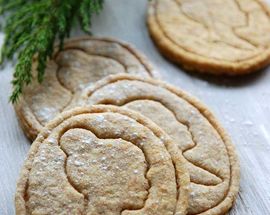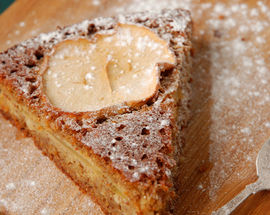Advent and Christmas in particular attract thousands of foreign visitors who happily join the locals in munching on the rich festive food. And because delicious bites, especially desserts, turn up at food stalls as early as late November, feasting happens over a much longer time than it used to in the old days.
Tourists who land in Croatia only for a few days in the winter struggle with the following riddle. They eat the same amounts of the same rich food, but while they end up with muffin tops, Croatian locals manage to keep their perfectly slim figures. This may seem like a mystery, but the explanation is simple, even if not always obvious. Not even to the Croats.
Eating sweets in Croatia during winter has a subtle logic of its own: the logic of cycles. Starting from late November and all the way to early spring, Croatians exchange times of denying and indulging their sweet tooth. No one imposed these rules as a weight management system. But it just so happens that the Christian traditions of fasting and feasting produce a side-effect that is beneficial to the locals’ figure. Yes, they have a religious meaning, but they also create a perfectly balanced relationship we have with our sweets.
Fast number one: four weeks of Advent
Zagreb Advent is the richest display of winter festivities in Croatia. This award-winning festival offers visitors a taste of our traditional festive cakes weeks before Christmas Day arrives. For tourism purposes, this is amazing, because foreigners can now get to know our rich culinary culture. Still, the original meaning of Advent is about giving up on the riches and giving up on rich food. This four-week countdown to Christmas is the time of fasting, which most Croatians do. They ramp up their veggies intake and slow down on fatty and sugary food. Some for deeply religious reasons, others to slim down and pre-empt the joy blubber they could get from indulging in Christmas cakes later on.
Feast number one: Christmas to Epiphany
While elsewhere in the world, Christmas is celebrated with one particular cake – such as Christmas pudding in England – Croatians go all out with as many varieties as possible. To honour the dignified nature of this important religious holiday, each Croatian household will show off at least ten types of petite cakes, cookies and biscuits. This cake frenzy begins a few days before Christmas when Croatian women begin their traditional bake-off. Their goal is to produce as many kinds as possible, and all of them tiny, beautifully decorated, scrumptious bites of sweetness.Come Christmas Day, the feasting may begin. And the proper way to do it is to indulge your sweet tooth with no limitations at all. Being generous at feasting is just as important as being prudent at fasting. So sink into those deep chocolaty flavours, feel the crunch of walnuts and hazelnuts, get high on the lemon zestiness. From now on and during the 13 days which lead to Epiphany (6 January), Christmas sweets are eaten at every occasion you can think of. For breakfast, as a dessert, with coffee when the guests arrive, for late supper. Going all out with cakes is taken as seriously as abstaining from them during Advent.

Fast number two: dead winter
Croatians often perceive January as the longest month of the year. Maybe because there is little sunlight and the days seem to drag on. But also because they start yet another cycle of fasting. Christmas cakes dwindle away, the only trace of them showing as extra padding on the tummy and thigh areas. Health and figure conscious Croatians pledge to their New Year resolution, which is usually a January detox. Many people will also go skiing, using this as a perfect opportunity to exchange the pleasures of sweets with the delights of outdoor activities.Feast number two: Carnival time
Sticking to any kind of resolution, especially as regimented as a diet deprived of cakes, works only if there is a light at the end of the tunnel. And if the tunnel is not too long. Fortunately, the end of the frugal January brings a new opportunity for feasting: the carnival time. In continental Croatia it’s also called fašnik. Around mid February Croatians polish off vast quantities of doughnuts (on the continent) and fritule (Dalmatian small ‘drunken’ fritters). And this tradition is even dearer to them than dancing under a mask or pretending to be someone else.In the old days, homemade doughnuts were deliciously simple and usually filled with plum or apricot jam. Today, bakeries are the main source of these moreish sweets, and they make them with all kinds of fillings and toppings. The only difference now is that bakeries keep tabs on how many they make and how many we devour. Not to shame us, of course. It’s just statistics.
Fast number three: 40 days of Lent
Croatians take Lent seriously. After Shrove Tuesday, the consumption of sweets noticeably decreases. There are no official numbers to prove that. But if you go around the country and ask the locals what they are giving up during Lent, many will say: sweets. This includes chocolate, ice-cream or anything else that contains sugar. Some go as far as connecting sugar with alcohol and grains and so they stop drinking and eating bread. Many couples wait for Lent to be over to get married, i.e. to become official sweethearts. So Lent without sweets has a deeper meaning than just taking time off cakes.Feast number three: Easter
For Croatians, Easter is the most important religious holiday. And just as Lent, it is understood in both its material and metaphorical sense. If that wasn’t so, no one would be able to last for 40 days denying their sweet tooth. As a symbol of rebirth, Easter is celebrated with bready types of cakes. And those who refrained from bread during Lent finally get to balance out their fast.Unlike Christmas cakes galore, Easter breakfast calls for only one type of cake. This is usually pinca (traditional Easter bread) or a fluffy plaited loaf. These cakes are not very sweet because they are eaten with roast ham and boiled Easter eggs. Later on, there is more sweetness to come but still in the remit of simple and rustic. The usual suspects are walnut and poppy seed loafs, always made together as if they were twin brothers. If you ask why, a Croatian mother will reply: oh, my husband and son only like walnuts but I’m crazy about poppy seed. The walnut/poppy seed question in Croatia is the equivalent of the cat/dog person one in English.
After Easter celebrations, the collective cycles of winter sweetness come to an end. People will engage in their own, private journeys. There will be birthday parties, weddings and all kinds of occasions when the sweet tooth will demand their attention. They will, of course, oblige and then decide to go easy for a while. After all, summer season will soon knock on the door and everyone will want to look great on the beach.
To the sun-loving Croatians, winter may seem like the longest season of the year. Which is why they need more sweets to sail through the days that are glum and gloomy. But it’s also why the cycles of fasting and feasting are crucial for keeping the balance. The cycles may be invisible to the naked eye, but they have been running in the background for ages. To keep the locals slim and smiling.












Comments